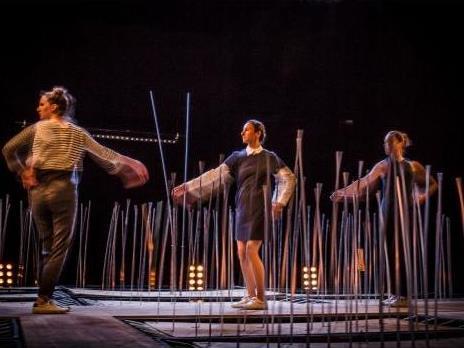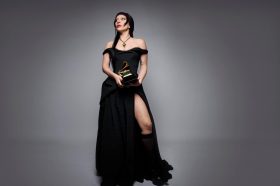Tremor at Arts House. Photograph by Bryony Jackson.
I love science and I love sound. No surprise, then, that Ashley Dyer’s offering of a sound-activated sculptural set for his work Tremor was right up my alley. Various lengths of metal are nailed upright to a base of wood, which is attached in turn to sprung metal frames. These have subwoofers placed underneath them, sending various frequencies and vibrations through to the pieces of metal, that bend and wobble and hum with the waves of sound running through them. Neat, huh?
It seems strange, then, to find out upon further reading that this work was inspired by the Christchurch earthquakes of 2011. Ashley Dyer’s choice to take such an unpredictable, natural, emotionally charged and senseless event, and turn it into a work governed by precision, discipline and order, is certainly unexpected.
As is almost ubiquitous with contemporary dance works, the catalysing ideas behind the project (the earthquakes) were not something that I thought about at all during the work. I saw a very cool sound sculpture, interspersed with moments of dancers being endurance-tested using a very limited vocabulary of movements that occasionally had the effect of an optical illusion, with performers’ faces blurring out of recognition through rapid movement, or with bodies twisting in such ways that it was hard to remember which way was back and which was front.
I want to emphasise again the beauty of the set/sound sculpture. Watching the pieces of metal bend, resonate and bob was hypnotic, and I would have very happily watched that alone for an hour, with little or no human presence. Overall, though, the governing tone of the piece seemed to be ‘cool’. I was engaged for the most part, but only ever at a cool intellectual distance. The work did not feel urgent, and for all its intellectual distance, it didn’t give me very much to think about. As the audience we remained seated and static for the duration of the show. Whilst there may be something to be said for being a fixed point in a space that vibrates and oscillates, I would have liked the opportunity to interact with the sculpture or to move around the space and see what that would do to my experience of the vibrations.
There were parts of the show involving a wine glass being budged around a table by vibrations beneath the table. When I expressed enthusiasm for this element of the show to a friend, he dismissed it as a gimmick. But for me, this ‘gimmick’ was a microcosm of the rest of the show. And why is ‘gimmick’ such a dismissive word? It takes skill, it’s entertaining, and it can sometimes elucidate a deeper metaphoric resonance. More awareness of ‘gimmick’ might have elevated this piece. Or maybe a different direction – maybe more of the dancers; more testing of their bodies; more relentless, unstoppable repetition. In any case, for me this show sat at the intersection of some interesting territories, but didn’t commit fully enough to any of them to sustain my interest.
Rating: 3 stars out of 5
TREMOR
Lead Artist: Ashley Dyer
Sound Designer: Nigel Brown
Principal Dancer: Kristy Ayre
Dancers: Nat Cursio and Jo White
Set Design: Jason Lehane
Lighting Design: Travis Hodgson
Production Manager: The Rubix Cube
Performers and Assistants: Lindsay Templeton and James Hogan
Associate Producer: Kristina Arnott
Arts House
16-20 November 2016




